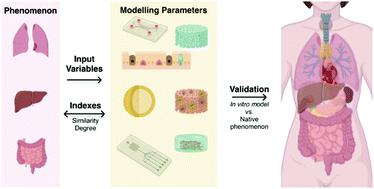当前位置:
X-MOL 学术
›
Biomater. Sci.
›
论文详情
Our official English website, www.x-mol.net, welcomes your
feedback! (Note: you will need to create a separate account there.)
From tissue engineering to engineering tissues: the role and application of in vitro models
Biomaterials Science ( IF 5.8 ) Pub Date : 2020-11-10 , DOI: 10.1039/d0bm01097a Daniela Peneda Pacheco 1, 2, 3 , Natalia Suárez Vargas 1, 2, 3 , Sonja Visentin 3, 4, 5, 6 , Paola Petrini 1, 2, 3, 7, 8
Biomaterials Science ( IF 5.8 ) Pub Date : 2020-11-10 , DOI: 10.1039/d0bm01097a Daniela Peneda Pacheco 1, 2, 3 , Natalia Suárez Vargas 1, 2, 3 , Sonja Visentin 3, 4, 5, 6 , Paola Petrini 1, 2, 3, 7, 8
Affiliation

|
Engineered models have emerged as relevant in vitro tools to foresee the translational potential of new therapies from the bench to the bedside in a fast and cost-effective fashion. The principles applied to the development of tissue-engineered constructs bring the foundation concepts to engineer relevant in vitro models. Engineered models often face scepticism, because regularly these do not include the extreme complexity of nature, but rather a simplification of a phenomenon. While engineering in vitro models, a hypothesis is imposed towards which defined parameters are included to assess the degree of similarity between the in vitro model and the native phenomenon, keeping in mind their intrinsic limitations. The development of in vitro models has been highly supported and disseminated by different regulatory agencies. This review aims at defining and exploring the multifaceted potential of tangible, not theoretical, models within the biomedical field to represent physiological tissues and organ-related phenomena.
中文翻译:

从组织工程到工程组织:体外模型的作用和应用
工程模型已经成为相关的体外工具,可以快速,经济高效地预测从长凳到床头的新疗法的转化潜力。用于组织工程构造的开发的原理为工程相关的体外模型带来了基础概念。工程模型经常面临怀疑,因为通常这些模型不包括自然界的极端复杂性,而是现象的简化。在设计体外模型时,会提出一个假设,其中包括定义的参数,以评估体外模型与自然现象之间的相似程度,同时牢记它们的固有局限性。的发展体外模型得到了不同监管机构的高度支持和传播。这篇综述旨在定义和探索生物医学领域中代表生理组织和器官相关现象的有形而非理论模型的多方面潜力。
更新日期:2020-12-16
中文翻译:

从组织工程到工程组织:体外模型的作用和应用
工程模型已经成为相关的体外工具,可以快速,经济高效地预测从长凳到床头的新疗法的转化潜力。用于组织工程构造的开发的原理为工程相关的体外模型带来了基础概念。工程模型经常面临怀疑,因为通常这些模型不包括自然界的极端复杂性,而是现象的简化。在设计体外模型时,会提出一个假设,其中包括定义的参数,以评估体外模型与自然现象之间的相似程度,同时牢记它们的固有局限性。的发展体外模型得到了不同监管机构的高度支持和传播。这篇综述旨在定义和探索生物医学领域中代表生理组织和器官相关现象的有形而非理论模型的多方面潜力。









































 京公网安备 11010802027423号
京公网安备 11010802027423号